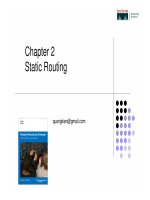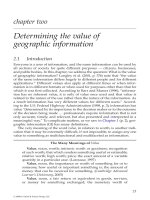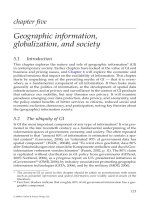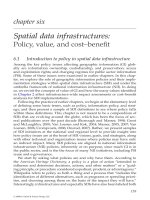Precast concrete materials, manufacture, properties and usage - Chapter 2 pot
Bạn đang xem bản rút gọn của tài liệu. Xem và tải ngay bản đầy đủ của tài liệu tại đây (105.57 KB, 10 trang )
2
ADMIXTURES
This chapter covers the range of admixtures used in precast concrete
products and mortars used with precast masonry. They are all used at
relatively low concentrations (0·01–5% w/w cement) for the purpose of
modifying the properties of the fresh and/or the hardened material. The
chapter excludes additives such as ground blast furnace slag and
pulverised fuel ash (fly ash), the latter being covered in Chapter 4.
Pigments, although in the admixtures group, are covered in the next
chapter.
It is often stated that well-designed, compacted and cured concrete
should not need an admixture. However, when all the practical aspects of
a situation are considered such dogmatism can seldom be justified. The
author’s opinion is that, with the complexity of castings, the chance to
reduce water contents for the same workability, and with the many other
advantages that admixtures can bestow, there are few cases where their
non-use can be justified. However, one point that needs to be emphasised
is that admixtures are used at relatively low concentrations and over or
under dosage can lead to potentially disastrous results. Control of the
basic ingredients of aggregate, cement and water must be strict because
if there is any doubt about this there is no point in using admixtures. The
admixtures are used to make good concrete products better, not to make
poor or mediocre concrete good.
Having said all this, one can now proceed to discuss admixtures under
performance headings.
2.1 ACCELERATORS
The purpose of these is to accelerate the setting and hardening rates of
cement for the main purpose in precast work of getting a faster turnover
Copyright Applied Science Publishers Ltd 1982
rate in demoulding and stacking and faster delivery times. The most
common and the cheapest accelerator is calcium chloride. Calcium
formate, sodium nitrite and others are not so effective as calcium chloride
and are extremely sensitive in their performance to the chemistry of the
Portland cement. This is particularly noticeable with the C3A (tricalcium
aluminate) content where the acceleration effect is less marked as the
C3A content increases, especially above the 8% level. (See Table 2.4,
later.)
Calcium chloride, largely due to abuse by either overdosing and/or use
in poor or mediocre quality concretes, resulted in a ban in some countries
on its use in concretes containing embedded metals. It is a pity that this
ban also applies to precast concrete companies who used calcium
chloride for over twenty years without a single performance claim ever
being lodged. The admixture is still permitted in many countries for
reinforced concrete, and in the countries where it is banned it is still
permitted in concretes not containing embedded metals. Most countries,
wisely, ban the use of chloride-containing admixtures (above a maximum
level) in prestressed concrete.
The main overriding advantage of calcium chloride compared to other
chemical accelerators is that it works exceedingly well in every type of
Portland cement irrespective of the chemistry of the cement. On the other
hand, the following disadvantages obtain.
2.1.1 Corrosion
At normal dosage rates of 0·5–1·5% equivalent anhydrous material by
weight of cement it will promote corrosion in respect of:
(a) Accelerating the normal degradation of mediocre or poor quality
concrete.
(b) Migrating with moisture in the concrete towards the colder face
causing concentration gradients varying from, say 0·5 to 3·0%, from
an original uniform 1·5%.
(c) Accelerating the speed and deepening the depth of the carbonate
layer.
At excess concentrations, the pH becomes reduced below its average
level of 12 and when it approaches 9 corrosion will set in if air can get
to the steel as well. In addition, the hygroscopic nature of the material
will allow corrosion to occur even if protected from the weather areas.
The symbol ‘pH’ is a logarithmic term related to the hydrogen ion
Copyright Applied Science Publishers Ltd 1982
concentration in a solution. The value 7 refers to a neutral system, higher
numbers are alkaline and lower numbers acidic solutions and the range
is from 1 to 14.
At both concentrations, lime bloom (sometimes misquoted as
efflorescence) will be promoted and the potential shrinkage of the
concrete will be enhanced by 25–35%. This latter aspect is probably one
of the most important associative factors in the use of calcium chloride
because it becomes a crack-promoting factor, especially when the section
is restricted by heavy reinforcement. In the vast majority of trouble-
shooting works and site visits undertaken by the author where calcium
chloride has been involved, cracking occurred before steel corrosion and
not as a result of it. In effect, all such exercises should be carefully
documented and dates and ages of defects recorded.
2.1.2 Retardation
Although this may appear a rather enigmatic subheading, a fault with
calcium chloride (and other chlorides) when used at low concentrations
is that severe retardation in early strength occurs at ‘trigger’ points in the
concentration range 0·0005–0·05%anhydrous calcium chloride by
weight of cement. These concentrations are likely to arise in practice
from, for example:
(a) Using a mixer for a non-chloride mix without thorough washing
from an earlier chloride-containing mix.
(b) Other admixtures containing trace chloride concentrations.
(c) Use of aggregates containing trace chloride concentrations.
The effect is believed to be due to an exothermic ‘punch’ at 10–12 hours
from the time the water was added when the equivalent of 1 kW/m
3
can
be emitted over a 20–30 minute period. The concrete, at this tender age,
would suffer distress in the form of microcracking and aggregate/cement
debonding. Table 2.1 illustrates this effect.
There is not a strict pattern, but the two trends of retardation at and
below 0·1% and the decreasing defect with the higher water/cement (W/
C) ratios can be seen. It is known to the author that this effect was almost
certainly responsible for the in-works breakage of several large cladding
units made from ‘non-chloride’ mixes following the earlier cold
morning’s chloride-containing castings. It is also interesting to note that
the chloride level of 0·001% is close to the level obtained in typical tap
water as equivalent calcium chloride. However, the chemical in tap water
Copyright Applied Science Publishers Ltd 1982
is generally sodium chloride and this has not been found to be as effective
as calcium chloride in bringing about these retardations. One thing that
these findings do indicate is the danger of inter-laboratory comparative
testing with the same aggregates, cement, etc., unless distilled, de-ionised
or identical waters are used in all cases.
The retardation effect is only regained in part at later ages as Table 2.2
shows. It can be seen that early accelerated strengths are not maintained
at later ages. Chemical retarders act in the opposite way but, as already
stated, this retardation effect is thought to be due to physical causes.
TABLE 2.1
RATIO TO CONTROL STRENGTH FOR 24 HOUR OLD 4/1 MORTAR CYLINDERS
TABLE 2.2
24 HOUR AND LATER AGE COMPARATIVE STRENGTH FOR 4/1, 0.5 W/C
MORTARS
Copyright Applied Science Publishers Ltd 1982
The admixtures should be obtained in liquor or solution stock form
and dispensed into the mixer at the same time as the addition of the
mixing water. Stock solutions may be made out of industrial flake and
the amount required calculated from the solution SG (specific gravity) as
in Table 2.3. The water requirement of the mix must be calculated to
include for the water in the solution in total or effective W/C
calculations.
TABLE 2.3
CONCENTRATION VERSUS SG OF
CaCl
2
STOCK SOLUTIONS
A demand for non-chloride accelerators following the ban in some
countries has existed since the middle sixties but substitutions by
formates, citrates, nitrites, etc., cause problems, as mentioned earlier,
because of their sensitivity to the tri-calcium aluminate level in the
cement as Table 2.4 shows.
TABLE 2.4
COMPARATIVE CUBE STRENGTH TYPICAL COMPARISONS WITH
CALCIUM FORMATE AT 1.0% w/w CEMENT
Copyright Applied Science Publishers Ltd 1982
It can be seen that the best results are obtained with a low C3A
cement, and ordinary Portland cements with levels of C3A well under
10% and sulphate-resisting cements are the only types that will
apparently benefit. The choice is between the use of plasticising and
superplasticising admixtures as indirect accelerators (through reduction
of the W/C) and the development of other economic accelerating
chemicals.
2.2 PLASTICISERS
These are available in three forms:
(a) Normal—neither accelerating nor retarding
(b) Retarding
(c) Accelerating
They are usually based upon calcium lignosulphonate or carboxylic acid
and plasticise by placing negative electrostatic charges on particle
surfaces thus causing them to repel one another. As a group of
admixtures they have the most promise in both the precast and in situ
concrete industries because they enable one to reduce the W/C for the
same workability as the control mix (indirect accelerator effect), to
improve the workability for the same W/C as the control with the same
ensuing strengths, or to have a mixture of both. In effect, this means an
interim W/C with improved workability. Table 2.5 illustrates this effect.
TABLE 2.5
TYPICAL EFFECT OF PLASTICISING ADMIXTURE ON
PROPERTIES OF A VIBRATED CONCRETE PRODUCT
The dosage rates vary from 100 to 1000 ml/50 kg cement and each
type should be dispensed at the same time as the mixing water. As far as
Copyright Applied Science Publishers Ltd 1982
selection is concerned, much of this appears to be a function of the
grading of the fine aggregate. The coarser sand mixes benefit more with
the lignines, whereas the finer dune sands work better with the
carboxylic derivatives. Some of the lignines have free sugar radicals left
in them in the extraction process and these are largely responsible for the
retardation. These are left in for the (b) type but removed for the (a) type,
and, for the (c) type, not only removed but replaced by chloride or other
accelerators.
The (a) and (b) types are the most commonly used in the precast
industry, mainly in the wet-cast vibrated process, and their main
applications are for indirect acceleration, workability and surface
finish.
2.3 SUPER-PLASTICISERS
These are more vigorously acting agents based upon chemicals such as
the naphthosulphonates and formaldehydes and work by the same
electrostatic mechanism as described in Section 2.2 but with stronger
dipole yet short-lived (30–60 minutes) forces. Their addition rates are
rather higher than for plasticisers and range approximately from 200 to
2000 ml/50 kg depending upon the effect required. Their short active life
is exemplified by the workability characteristics, which return to those of
a no-admixture situation over 30–60 minutes depending mainly upon
temperature. This makes them more applicable to precast rather than in
situ work due to the shorter times between mixing and usage. In ready-
mixed concrete work the admixture needs to be added to the mixer truck
on site.
There are two ways in which these super-plasticisers can be used:
(a) By controlling the initial workability stringently before addition, to
give a flowing concrete requiring minimum compactive effort
coupled with little or no bleeding.
(b) By reducing the W/C for a vibratable type concrete workability.
System (a) is not only difficult to achieve but the mould work has to be
designed to resist what is, in effect, a liquid with an SG of about 2.4.
System (b) is far more attractive for precast work and is the only one that
should be considered.
Copyright Applied Science Publishers Ltd 1982
2.4 WATER REPELLENTS
These are hydrophobic capillary-lining materials in the form of metallic
soaps such as calcium or aluminium stearate. They can be added to the
mix at 0·5–2·0% w/w cement concentration in the form of the metallic
soap, or can be added to wet concrete mixes at the mixer stage in the
form of stearic acid, which will immediately react with the free lime to
form the metallic soap which is the water repellent agent. In all forms the
admixture comes as a fine low-bulk-density white powder. The main
application is in hammer-compacted architectural units such as cast stone
whose mediocre to high permeability needs to be compensated for to
inhibit crazing, dirt formation and mould growth. An experiment on cast
stone samples with calcium stearate concentrations from 0 to 2·0% w/w
cement, weathering on a roof site for 10 years showed that the addition
of the water repellent resulted in vastly improved durability. The control
sample broke up due to frost and algae attack, the 0·1–0·5%
concentrations showed slight dirtying and the 1·0–2·0% samples
remained pristine. The admixtures have a particular application in
pigmented concretes where they help to retain the colour.
Water repellents should never be used in a mix containing either
plasticisers or super-plasticisers. The hydrophilic and hydrophobic effects
will be in opposition and a very patchy product will result.
As far as the effects on strength are concerned the addition of stearates
has a small retardation effect on the wet mix but improves the earth-
moist mixes, probably due to retention of moisture in the low-water-
content mix used. This is exemplified by the typical results shown in
Table 2.6.
TABLE 2.6
CONTROL CUBE STRENGTH COMPARISONS FOR CALCIUM STEARATE ADMIXTURE
2.5 AIR ENTRAINERS
Although air entrainment agents (AEA) are widely applied to in situ
Copyright Applied Science Publishers Ltd 1982
concretes, mainly for frost and de-icing chemical durability, they have a
minimal application in precast work.
The admixture is in liquid form and based upon either the sodium salt
of the vinsol resin or complex sulphonates or similar agents which are
added at about 100–500 ml/50 kg of cement (depending upon the mix
details and type of agent). They should impart to the mix a modified
capillary structure by producing a stable fresh concrete system containing
approximately uniformly sized and spaced bubbles, which act as safety
valves in the freeze-thaw mechanisms. This improved resistance is alleged
to obtain when de-icing chemicals are used, as well as when they are not,
but the evidence (discussed in Chapter 8) casts doubt upon the benefits in
the former case.
The only precast products that can benefit from proper air
entrainment are wet cast vibrated units that are used in and around
ground level, viz. paving slabs, kerbs, abutment units, flower pots, litter
bins, etc. However, the vast majority of slabs and kerbs are made by
machine-intensive methods where, due to their workability aiding effect,
air-entrainment-agent-containing products will generally have less air in
them than the control concretes.
Fresh concrete air content tests only reveal how much air there is in
the mix and not how much is entrapped and entrained, and not the
entrained form of air. A microscopic study or a standard freeze-thaw test
is necessary to assess the performance of such concrete. About 5% of air
v/v concrete is required and the efficiency is mainly a function of the
cement content and the fine aggregate grading.
2.6 ANTI-MOISTURE MIGRATORS
This is not a common categorisation of admixtures, but is still a
significant field bearing in mind that the admixtures considered in
Sections 2.2, 2.3 and 2.4 do result in some anti-moisture benefits, but not
enough to promote them as bedding and pointing mortar admixture for
high suction substrates such as autoclaved aerated concrete, cast stone
and/or for hot-weather working conditions where pointing has to be
undertaken.
The most popular admixture is the same as the cellulose used for wall-
papering. The common basic chemical is methyl ethyl cellulose used as a
0·5–1·0% w/v solution in the gauging liquid for the mortar. Such mortars
are virtually unaffected by dry high suction surfaces and stay workable
Copyright Applied Science Publishers Ltd 1982
for a period up to about two hours even at temperatures as high as 40°C
and at relative humidities down to 10%.
2.7 PRODUCT APPLICATIONS
With the foregoing discussion in mind, one can list the applications for
the products/admixtures described in the preceding sections:
2.1 Vibrated reinforced and unreinforced concretes (reinforced units
only if permitted by regulations).
2.2 (a) and (c) as 2.1 and pressed and extruded products.
2.2 (b) ready-mixed mortars delivered to site.
2.3 As 2.2.
2.4 Cast stone, coloured and architectural concretes without 2.2 and 2.3
present.
2.5 Vibrated roadside units.
2.6 Pointing and bedding mortars.
In addition to the point made that water repellents should not be used
with plasticisers or super-plasticisers, other admixtures can be coupled
provided that trial mixes and the hardened concrete properties are
acceptable. A few ‘nots’ for guidance:
2.1 Do not use chlorides in prestressed work, formates in high C3A
cements, nor with HAC or SRPC.
2.2 Do not add after the mixing water, and do not add too much mixing
water.
2.3 Do not use stearic acid powder in earth-moist mixes nor with 2.2
types.
2.4 As 2.2, nor without a performance assessment.
2.5 Do not overdose (unlikely on a cost basis but disastrous if done).
2.6 Do not underdose.
BIBLIOGRAPHY
CI’80 International Conference, Admixtures Session, April 1980, London.
Copyright Applied Science Publishers Ltd 1982









